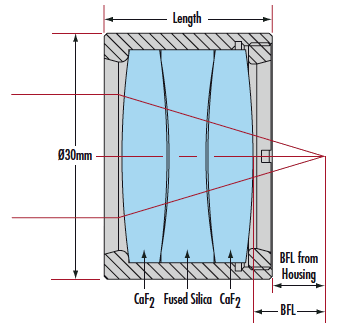무엇을 도와드릴까요?

 TECHSPEC® 부품은 에드몬드 옵틱스가 설계, 사양 지정 및 제조하는 제품입니다. 더 알아보기
TECHSPEC® 부품은 에드몬드 옵틱스가 설계, 사양 지정 및 제조하는 제품입니다. 더 알아보기
| 가격(부가세 별도/Tax excluded) | |
|---|---|
| 수량 1-5 | KRW 3,905,554 개당 |
| 수량 6-10 | KRW 3,320,102 개당 |
| 수량 11-25 | KRW 3,124,402 개당 |
| 더 필요하신가요? | 견적 요청 |
광대역 용도를 염두에 두고 고안된 당사의 UV-to-NIR corrected lenses는 193nm - 1000nm 범위의 파장에서 일정한 초점 거리(제품 자료에 있는 chromatic shift 정보 참조)를 제공합니다. 최상급의 플루오린화칼슘 및 용융 실리카 소재로 제조되는 이 infinite-conjugate triplet은 광대역 파장을 활용하는 이미징 용도에 안성맞춤입니다. 대표적인 용도로는 가시광 및 근적외선에서 방출되는 빛에 대한 형광 연구, 동일 렌즈를 사용해 여기 물질에 빛을 가하고 이로부터 방출되는 빛을 모으는 듀얼패스 시스템이 있습니다. 광학 요소는 비코팅 상태로 30mm 직경의 알루미늄 하우징에 장착되어 있습니다. 무반사(AR) 코팅 처리가 가능하며, 주문 시 최소 수량이 적용됩니다.
Prescription 전체 데이터를 이용할 수 있습니다.

| Effective Focal Length EFL | 193 - 400nm | 400 - 1000nm | 193 - 1000nm | |||
| Chromatic Shift | RMS Spot Size | Chromatic Shift | RMS Spot Size | Chromatic Shift | RMS Spot Size | |
| 36mm | 1.8mm | 240μm | 0.4mm | 214μm | 2.2mm | 268μm |
| 45mm | 1.1mm | 88μm | 0.3mm | 69μm | 1.3mm | 95μm |
| 90mm | 2.0mm | 64μm | 0.6mm | 38μm | 2.5mm | 69μm |
| 135mm | 1.6mm | 49μm | 0.6mm | 31μm | 2.1mm | 51μm |
| 180mm | 1.4mm | 46μm | 0.6mm | 28μm | 1.9mm | 45μm |
본사 및 지사별 연락처 확인하기
견적 요청 도구
재고 번호 입력 필요
Copyright 2023, 에드몬드옵틱스코리아 사업자 등록번호: 110-81-74657 | 대표이사: 앙텍하우 | 통신판매업 신고번호: 제 2022-서울마포-0965호, 서울특별시 마포구 월드컵북로 21, 7층 (서교동, 풍성빌딩)
The FUTURE Depends On Optics®